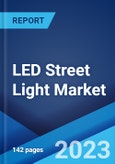The global LED street light market size reached US$ 10.1 Billion in 2022. Looking forward, the publisher expects the market to reach US$ 22.1 Billion by 2028, exhibiting a growth rate (CAGR) of 14.01% during 2023-2028.
The LED technology has evolved significantly over time, which has led to a reduction in their production costs and simultaneous improvements in efficiency and performance characteristics. These enhancements have enabled the technology to be combined with roadway and exterior area lighting such as streetlights and floodlights. Nowadays, the incorporation of street lighting with energy-efficient, modern LED systems has presented numerous opportunities for building a secure and connected city lighting network. On account of their longer lifespan and lower energy consumption, various cities around the world have adopted LED streetlights.
2. What are the global LED street lighting market drivers?
3. What are the key industry trends in the global LED street lighting market?
4. What is the impact of COVID-19 on the global LED street lighting market?
5. What is the global LED street lighting market breakup by application?
6. What are the major regions in the global LED street lighting market?
The LED technology has evolved significantly over time, which has led to a reduction in their production costs and simultaneous improvements in efficiency and performance characteristics. These enhancements have enabled the technology to be combined with roadway and exterior area lighting such as streetlights and floodlights. Nowadays, the incorporation of street lighting with energy-efficient, modern LED systems has presented numerous opportunities for building a secure and connected city lighting network. On account of their longer lifespan and lower energy consumption, various cities around the world have adopted LED streetlights.
- Retrofit
- Retail & Hospitality
- Outdoor
- Offices
- Architectural
- Residential
- Industrial
Regional Insights:
- India
- China
- Europe
- United States
- Japan
- Brazil
- Russia
- Other Regions
Competitive Landscape:
The competitive landscape of the LED lighting industry has also been analyzed with details of the key players operating in the market across the globe.Key Questions Answered in This Report
1. What is the global LED street lighting market growth ?2. What are the global LED street lighting market drivers?
3. What are the key industry trends in the global LED street lighting market?
4. What is the impact of COVID-19 on the global LED street lighting market?
5. What is the global LED street lighting market breakup by application?
6. What are the major regions in the global LED street lighting market?
Table of Contents
1 Preface3 Executive Summary11 Loans and Financial Assistance13 Key Player Profiles
2 Scope and Methodology
4 Introduction
5 Global LED Lighting Market
6 Performance of Key Regions
7 Market by Application
8 Competitive Landscape
9 LED Street Light Manufacturing Process
10 Project Details, Requirements and Costs Involved
12 Project Economics
Methodology

LOADING...
Table Information
| Report Attribute | Details |
|---|---|
| No. of Pages | 142 |
| Published | September 2023 |
| Forecast Period | 2022 - 2028 |
| Estimated Market Value ( USD | $ 10.1 Billion |
| Forecasted Market Value ( USD | $ 22.1 Billion |
| Compound Annual Growth Rate | 13.9% |
| Regions Covered | Global |









